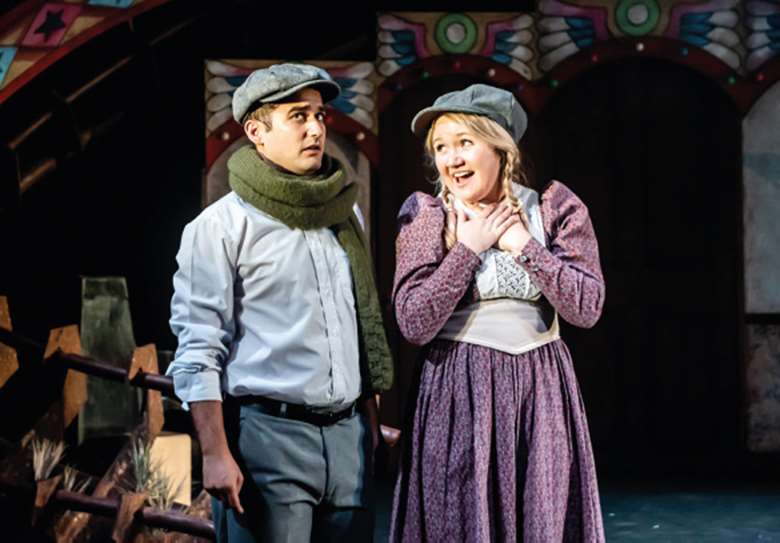The Wolves of Willoughby Chase
Joan Aiken, Russ Tunney, Aimee McGoldrick
Monday, May 1, 2023
Each issue of D&T we bring you a page-to-stage focus on a play for performing with your students. This issue, Aimee McGoldrick introduces The Wolves of Willoughby Chase.

LIDIA CRISAFULLI
The Wolves of Willoughby Chase is a play based on Joan Aiken’s 1962 novel of the same name. Russ Tunney has adapted the story for stage to include the presence of a strong storytelling chorus, which provides ample opportunity for physical theatre and interesting vocal performances. It has been written as a play with music, but it is left to the director’s discretion as to whether the music is used in their production.
The story
Set during the fictional 19th-century reign of King James III, the play tells the story of an England that has been overtaken by migrating wolves, who now roam freely around the country. We follow the story of Bonnie, who is the daughter of Sir Willoughby and Lady Green. We learn that she and her orphan cousin have been left in the care of a distant fourth cousin, Letitia Slighcarp, who turns out to be the villain of the play. The evil duo of Letitia Slighcarp and her sidekick Mr Grimshaw rid the girls of all toys and eventually send them to a Victorian style workhouse, leaving them with the house and money. It is down to the girls to get it all back.
Getting the cast hooked
Your audience will potentially know the story from the 1962 film starring Mel Brooks and Stephanie Beecham, but it is a more obscure choice for a child or teen cast. Watching the film may help a cast become invested in the storyline ahead of the rehearsal process. The film has slightly gruesome moments combined with comedy, similar to the likes of Oliver! or Annie. There are amusing moments, as well as scenes where they will cover their eyes. It’s worth noting that several scenes from the film don’t make it into the play, most notably the squashing of Mr Grimshaw in the Victorian workhouse washing machine.
Casting
There are 15 named characters, with a chorus that narrates the story and a large number of school children required for the workhouse. The original production was performed with five actors, with a male actor cast in the role of Mrs Slighcarp. The author notes, ‘You should do whatever feels best for your company, but please do make her ghastly’.
Puppetry
The wolves are ‘characters’ within the story, which can be on stage or alluded to. The use of a haze machine and wolf shadow puppets can be quite a menacing addition to some pivotal scenes in the first act. Puppets can also be an important visual addition to the opening scene, as the train is attacked by wolves. The wolf puppets can travel downstage and engulf the stage right train carriage, which can be easily depicted with a spotlight on Sylvia and Mr Grimshaw, who sit on suitcases which move as though they are on a train.
Staging
As well as an upstage platform, we used a wooden dolls house downstage lit with battery‑ operated tealights. Instead of using the musical song in the prologue, we used the backing music, placing a dancer in centre stage with a smoke machine. The cast entered the stage in a tableau using a mix of the choral words suggested, performed in unison, repetition and echo.
An important visual element in the storyline is Bonnie’s house, Willoughby Chase. It has many secret tunnels, which play an important role in the story development when Bonnie is locked in a cupboard by Mr Grimshaw. We used the upstage platform to depict this, but it was staggered in height and L-shaped. The area that jutted towards the audience was the tallest, in front of which we had a flat with a hidden door covered in bookcase wallpaper to disguise the exit. This also meant that when Sylvia and Bonnie were creeping through the corridors, they could travel under the stage with an old-style lantern and battery-operated candle inside, allowing the audience to see the ‘secret’ actions of the girls.
Multiple opportunities
The reason we chose to stage The Wolves of Willoughby Chase because of the opportunities for young people to explore character, both as individuals and as an ensemble cast. The villainous characters are amusing and can be played quite melodramatically, while the choral aspects of the storytelling required the cast to work together to create atmosphere through physicality and voice. Before rehearsing the production, we had studied Ancient Greek theatre, melodrama and silent movies to allow the children to understand the importance of cohesion and bolder characterisation choices.
The Wolves of Willoughby Chase is available for performance courtesy of Nick Hern Books. http://nickhernbooks.co.uk/the-wolves-of-willoughby-chase-stage-version

